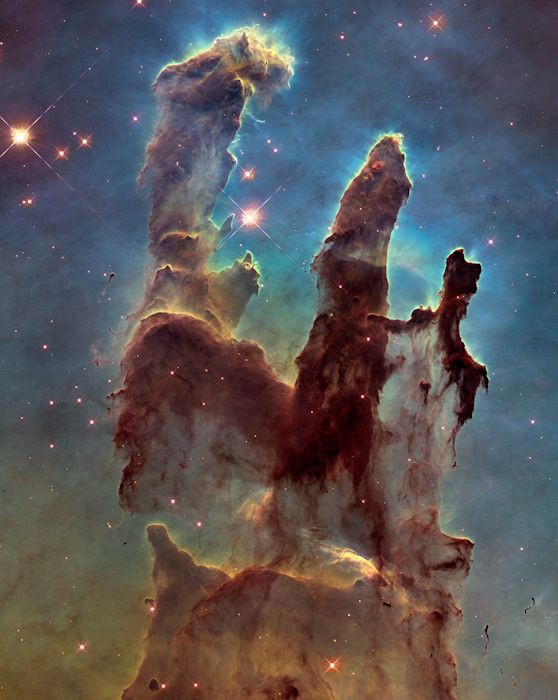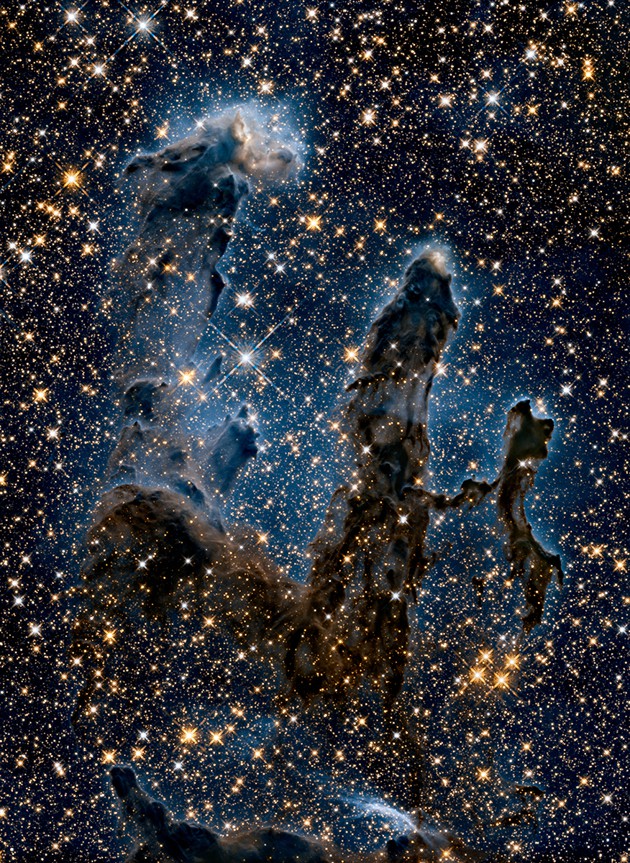The Extreme Hazing of the Most Expensive Telescope Ever Built

NASA
The James Webb Space Telescope, $8.8 billion and 20 years in the making, is undergoing rigorous testing to make sure it can survive launch.
The James Webb telescope is an incredible feat of human engineering. Its honeycomb-like mirrors, made of super-strong, lightweight beryllium and coated in gold, are designed to see in infrared, to detect the faint light exhaled by distant stars and galaxies. When it launches in two years, Webb, $8.8 billion and 20 years in the making, will be the most powerful space telescope ever built.
But first, scientists have to bolt it to metal plates and shake it violently.
The Webb lives in Greenbelt, Maryland, at NASA's Goddard Spaceflight Center, in a massive room built specifically to house the telescope. In the next few weeks, its golden mirrors and a set of four delicate instruments will undergo testing that simulates the conditions of its launch in October 2018 aboard an Ariane 5 rocket.* The tests are routine; all probes and satellites NASA sends into orbit undergo vibration and acoustics testing to ensure hardware can survive the shakes and sounds of a launch. In January, Webb’s instruments survived a different test at Goddard called Space Environment Simulator, which exposed them to the icy temperatures of space. This latest round of testing, Webb’s engineers say, is a formality. But that doesn’t mean they’re not nervous.
When “you get a telescope as built up as that, you don’t want anything to go wrong,” Jason Hylan, a Webb lead mechanical engineer, said during my recent visit to Goddard.
Webb has big shoes to fill, after all. The observatory will replace the Hubble Space Telescope, which has been orbiting the Earth since the mid-1990s. Hubble opened a new age of discovery in astronomy, revealing thousands of sparkling galaxies and disks of dust around new stars that will someday become the stuff of solar systems. Hubble has helped scientists understand some mysteries of the universe while presenting more.
With the Hubble’s legacy hanging over their heads, Webb’s engineers are erring on the side of caution. “Mother Nature has not been kind to us so far,” Jon Lawrence, the lead engineer for mechanical systems on Webb, wrote me in an email the Monday before Thanksgiving, on the first day of scheduled vibrations testing. It was windy, and the gusts were too powerful for a safe run, he said. The vibration system, constructed specifically for the Webb, is designed to shut off in case of any glitches. But engineers decided not to risk it with potential power outages.
Later that week, when the wind died down, the test began in earnest. The vibration system sits atop rubber airbags that diffuse the force of the machine, preventing it from sending dangerous vibrations through the building's foundation. Webb, draped in a tent made of fabric able to withstand launch conditions, is bolted to a metal plate. The plate is affixed to one table and shaken from side to side, then to another, which rattles it up and down. These motions impart thousands of pounds of force to the hardware, a few minutes at a time. Researchers review data from the vibration system after each run, before increasing force. At the test peak, the telescope is subjected to a G-force of 1.2, which feels like taking a sports car from zero to 60 miles per hour in about two seconds.
After that, the telescope will be wheeled into Goddard's acoustics chamber, a plain room with massive speakers shaped like vuvuzelas, where it will be subjected to sound-pressure equivalent to a jet engine at takeoff.
Early next year, Webb will be packed up and shipped to NASA’s Johnson Space Center in Texas, where it will be dipped into Chamber A, the world’s largest Space Environment Simulator. Webb doesn’t become Webb until it reaches California, where it will receive a tennis court-sized sunshield that will protect the mirrors and instrument from the sun’s heat, allowing them to stay cool. It will also be outfitted with spacecraft elements that will maintain the telescope’s orbit and communicate with mission control. By then, Webb will be too big to transport by land, so it will sail on a ship to French Guiana.
Webb will be 100 times more powerful than Hubble. “If you were a bumblebee on the moon, Webb would be able to spot you,” said John Mather, Webb’s senior project scientist, standing in front of the golden mirrors at Goddard. In its new home, 1 million miles from Earth, Webb will point its giant mirrors into the darkness and beam back images of the earliest universe like humans never seen before.
Take, for example, the “Pillars of Creation,” the thick stalks of interstellar gas and dust located in the Eagle Nebula, nearly 7,000 light-years from Earth. Here’s how Hubble saw them in 1995:

And here’s how they’re expected to look to Webb, which will find the stars Hubble can’t see because they’re obscured by dust:

That’s pretty spectacular.
But that’s getting ahead of the story. Webb has a busy two years to go, and the most nail-biting moments are still to come. Hubble owes its longevity to several visits from astronauts for repairs. When engineers discovered, just weeks after launch, that Hubble's mirrors weren’t working properly, NASA sent astronauts to fix it. But Webb, which will operate for five to 10 years, is not equipped to accept visitors, and NASA hasn’t set aside any funding for sending a crew if the worst happens. Unlike Hubble, Webb will launch folded up into its spot above Earth and take more than two weeks to unfurl. The automated process involves about 180 deployments, and there’s no rewind button. NASA officials say Webb can withstand the failure of about six steps, but not more.
Remember NASA’s “Six Minutes of Terror” in 2011? Engineers in California held their breath as the Curiosity rover, millions of miles away, slowed down from 12,000 miles per hour to almost zero as it descended through the atmosphere of Mars, where it would either land safely or explode spectacularly. That wait was nothing, compared to Webb’s deployment.
“We have two-and-a-half weeks of anxiety,” Amber Straughn, a NASA astrophysicist, told me at Goddard, a honeycomb-shaped gold necklace looped around her neck. For years, scientists have buzzed around Webb, testing and tinkering. Letting it go won’t be easy.



